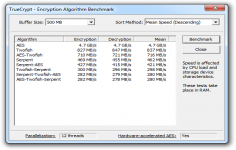 TrueCrypt 6.2
TrueCrypt 6.2
TrueCrypt Foundation - (Open Source)
Encrypting a USB key or a whole disk or even creating virtual encrypted disks, all these are possible with TrueCrypt.
TrueCrypt is a solution for storing encrypted information, allowing to create encrypted virtual disks. When mounted, the media appear in Explorer as a local disk. The application is also able to encrypt an entire volume or partition, which is very useful if there are sensitive information on the USB drive, for example. The encrypted volume is seen by the system as a typical hard and has all the features, being necessary only to enter the password associated with the volume at the time of "montage".
The software also includes hardware acceleration for encryption and decryption of AES algorithm. Enabled by default , this small revolution concerns only the recent Intel processors with the necessary capabilities : Intel Core i7- 980X , Intel Core i7 -970 , Intel Core i5- 650, Intel Core i5- 655K , Intel Core i5- 660, Intel Core i5 -661 , Intel Core i5 -670 , Intel Core i5 -680 and more, the speed of encoding and decoding being up to 8 times faster.
A volume can be mounted directly under Windows subject to provide the correct password. It is possible to create partitions and storage devices encrypted on the hard disk sectors with 4096, 2048 or 1024 bytes.
Many standard algorithms are supported by TrueCrypt, such as AES-256, Blowfish, CAST5, Serpent, Triple DES, and Twofish.
- Title:
- TrueCrypt 6.2
- File Size:
- 3.0 MB
- Requirements:
- Windows 2000 / XP / Vista / Windows7 / XP64 / Vista64 / Windows7 64 / Windows8 / Windows8 64
- Language:
- en-us
- License:
- Open Source
- Date Added:
- 11 May 2009
- Publisher:
- TrueCrypt Foundation
- Homepage:
- http://www.truecrypt.org
- MD5 Checksum:
- DC41720D117BD0E57288CEC56D81AE8A
New features:
* The I/O pipeline now uses read-ahead buffering, which improves read performance especially on solid-state drives, typically by 30-50%. (Windows)
Improvements, bug fixes, and security enhancements:
* The boot loader now supports motherboards with BIOSes that reserve large amounts of base memory (typically for onboard RAID controllers). Note: In order to be able to take advantage of this improvement under Windows Vista, you will have to install Service Pack 1 or higher first. Service Pack 1 for Windows Vista resolved an issue causing a shortage of free base memory during system boot. (Windows Vista/XP/2008/2003)
* Mounting using the 'Auto-Mount Devices' feature may take significantly less time as partitions containing unencrypted filesystems are now skipped. (Windows)
* When volumes that are mounted as read-only or removable are saved as favorite volumes, they are mounted as read-only and/or removable when 'Mount Favorite Volumes' is used.
* When a multiple-pass wipe algorithm is selected when performing in-place encryption of a non-system volume, the header areas will be wiped before the encrypted headers are written to the disk. Note: On an existing volume, you can perform such an operation by changing its password and/or keyfiles. (Windows)
* Many other minor improvements, bug fixes and security enhancements. (Windows, Mac OS X, and Linux)
Related software
2.2/5 from 179 users


